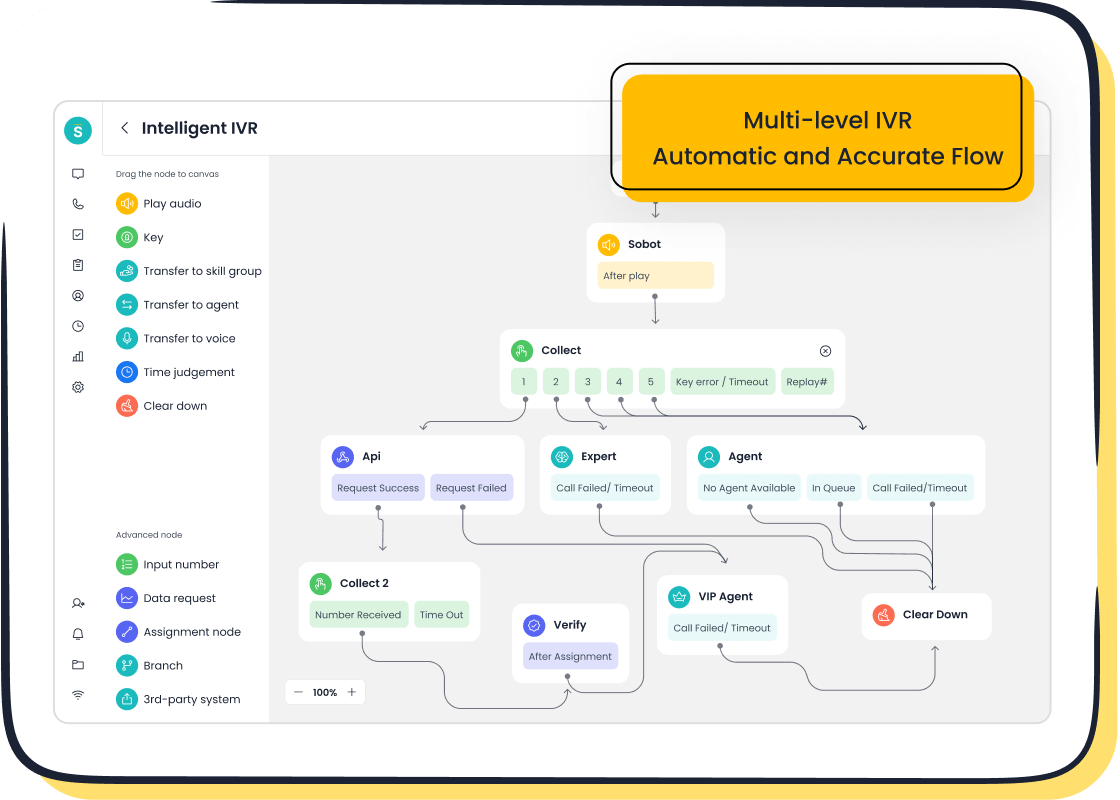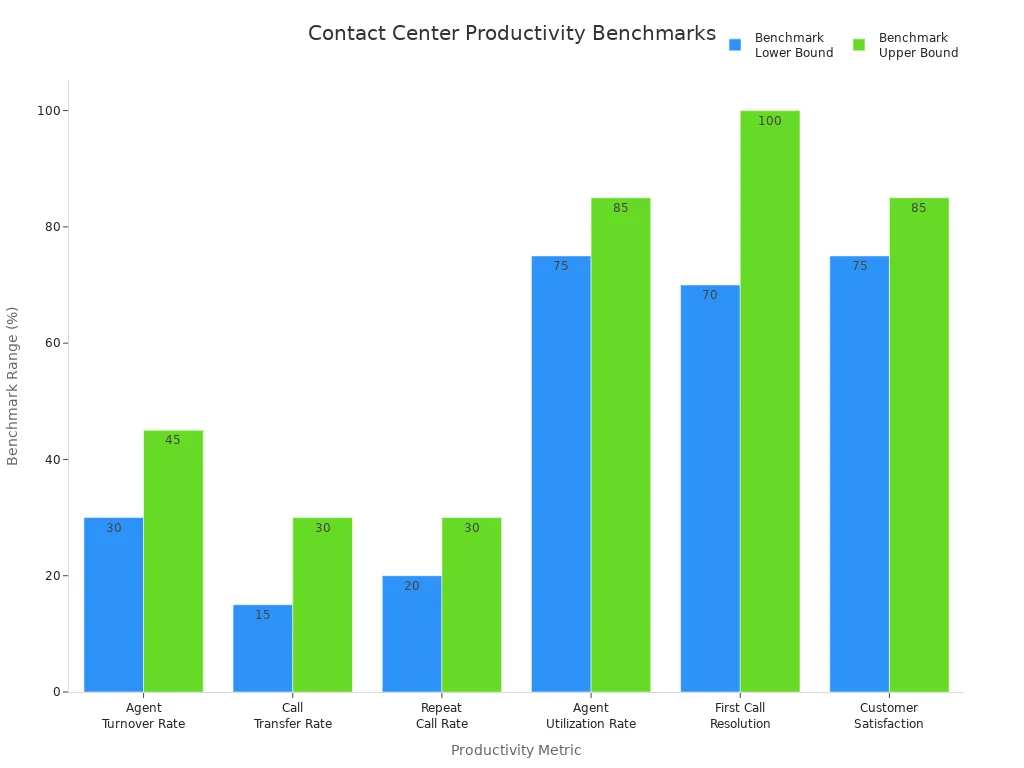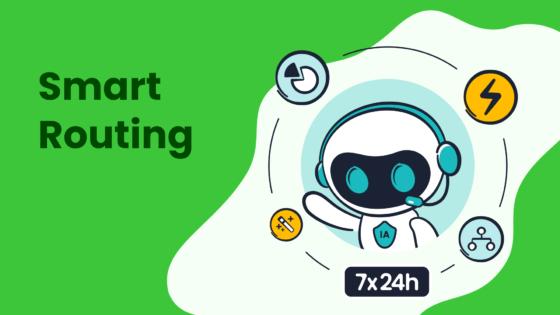Contact Center Agent Productivity Best Practices Revealed

Contact center agent productivity is crucial in shaping every customer support interaction, ultimately driving satisfaction and business growth. High-performing contact centers measure key metrics like First Call Resolution and Customer Satisfaction Score, which directly contribute to improved retention and revenue. Recent studies show that 91% of customers do not return after a negative experience, while companies delivering better customer experiences see a 42% increase in retention. Sobot call center solutions, powered by Sobot AI, enable organizations to boost agent productivity by streamlining workflows and providing agents with unified workspaces. Enhancing call center agent productivity is vital for modern customer support teams, and Sobot is at the forefront of delivering these capabilities.
Why Productivity Matters
Customer Experience Impact
Contact center agent productivity directly shapes customer experience quality. Productive agents resolve issues quickly, leading to higher Net Promoter Scores (NPS) and Customer Satisfaction (CSAT) ratings. Several key metrics highlight this connection:
- High first call resolution (FCR) rates, often around 78%, show that agents solve problems on the first contact, which boosts satisfaction.
- Low average speed of answer (ASA), such as 12 seconds, means customers wait less and feel valued.
- Efficient handling of calls, averaging about 4 minutes and 15 seconds, reflects streamlined processes.
When agents have access to unified workspaces and advanced tools like Sobot’s AI-powered solutions, they can respond faster and more accurately. This reduces customer effort and increases loyalty. Companies that focus on call center productivity see fewer call transfers and abandoned calls, both of which improve the overall customer journey. Providing agents with ongoing training and incentives focused on customer satisfaction, not just speed, further enhances these outcomes.
Operational Efficiency
Call center productivity also drives operational efficiency and cost savings. Organizations that optimize workforce management, invest in training, and leverage cloud-based technology like Sobot’s Cloud Call Center can reduce unnecessary expenses. The following table summarizes common strategies and their impact:
| Strategy | Cost Savings and Productivity Impact |
|---|---|
| Optimize Workforce Management | Avoids overstaffing and understaffing, aligns staffing with demand, boosts efficiency and service. |
| Invest in Training | Improves first-call resolution, shortens handling times, reduces turnover and training costs. |
| Leverage Cloud Technology | Cuts infrastructure and maintenance costs, supports remote access, and scales easily. |
| Self-Service Solutions | Reduces call volume by empowering customers to resolve issues independently, freeing agents for complex tasks. |
Sobot’s omnichannel platform streamlines workflows by unifying customer data and automating routine tasks. This allows agents to focus on high-impact interactions, which lowers average handle time and increases first contact resolution rates. As a result, businesses experience reduced operational costs and improved contact center productivity.
Employee Engagement
Agent engagement plays a critical role in sustaining high call center agent productivity. Research shows that 95% of employees value strong relationships with their managers, and recognition programs can boost productivity by up to 77.9%. When agents feel recognized and supported, their job satisfaction and retention rates increase. Satisfied frontline employees are four times more likely to stay with their organization for the next year.
Providing agents with the right tools, such as Sobot’s unified workspace and AI-driven insights, empowers them to perform efficiently. Balanced workloads, ongoing coaching, and clear career paths further enhance engagement. High agent engagement reduces absenteeism and turnover, which leads to a more stable and knowledgeable workforce. This stability translates into better customer experiences and higher call center productivity.
Measuring Contact Center Agent Productivity

Key Metrics & KPIs
Contact centers rely on clear agent productivity metrics to track and improve call center productivity. These metrics help managers understand how well agents perform and where to focus coaching. The most widely used agent productivity metrics balance speed, quality, and customer satisfaction. The table below summarizes the key metrics:
| Metric Name | Description |
|---|---|
| First Call Resolution (FCR) | Percentage of customer issues resolved during the first interaction. |
| Average Handle Time (AHT) | Average duration of a customer interaction, including talk and after-call work. |
| Average Speed of Answer (ASA) | Time taken to answer incoming calls. |
| After-Call Work (ACW) | Time agents spend on tasks after the call ends. |
| Occupancy Rate | Percentage of time agents are actively engaged in call-related activities. |
| Agent Utilization | Percentage of time agents handle customer interactions. |
| Adherence to Schedule | How well agents follow their assigned work schedules. |
| Customer Satisfaction (CSAT) | Reflects customer satisfaction with the service received. |
Sobot’s unified workspace and performance analytics make it easy for supervisors to monitor these metrics in real time. This approach supports continuous improvement in call center agent performance.
Setting Benchmarks
Benchmarks give contact centers a way to compare their call center productivity against industry standards. These targets help teams set realistic goals and measure progress. The table below shows common benchmark ranges for key metrics:
| Metric | Definition/Formula | Benchmark Range | Example Summary |
|---|---|---|---|
| Agent Turnover Rate | (Agents who left / Total agents) × 100 | 30% - 45% annually | 30% turnover if 60 of 200 agents leave yearly |
| Call Transfer Rate | (Transferred calls / Total calls) × 100 | 15% - 30% | 20% transfer if 200 of 1,000 calls transferred |
| Repeat Call Rate | (Repeat callers / Total customers) × 100 | 20% - 30% | 24% repeat if 1,200 of 5,000 customers call back |
| Agent Utilization Rate | (Talk time + after-call work) / Paid hours × 100 | 75% - 85% | 75% utilization if 6 of 8 hours spent working |
| First Call Resolution | (Calls resolved first time / Total calls) × 100 | Above 70% | 80% FCR if 80 of 100 calls resolved first time |
| Customer Satisfaction | (Satisfied customers / Total ratings) × 100 | 75% - 85% | Target CSAT rising to 85%+ |

Benchmarks vary by industry. Healthcare centers often see higher average handle times due to complex needs, while finance focuses on transfer rates and Net Promoter Scores. Sobot’s analytics tools help teams compare their results to these standards and adjust strategies to improve call center agent performance.
Data-Driven Insights
Data-driven insights play a key role in boosting agent productivity. By analyzing agent productivity metrics, managers can spot trends, identify coaching needs, and optimize workflows. For example, some organizations use analytics to shift non-essential tasks to off-peak hours, reducing call wait times by 30%. Others benchmark agent performance over time, using metrics like average handle time and first contact resolution rate to guide training and process changes.
Sobot’s unified workspace provides real-time dashboards and detailed reports. These tools help leaders find high-performing agents, replicate best practices, and address gaps in call center agent performance. With actionable insights, contact centers can increase call center productivity, reduce burnout, and deliver better customer experiences.
Technology Solutions for Call Center Productivity

AI & Automation

AI and automation have transformed call center productivity by streamlining repetitive tasks and supporting agents in real time. Many organizations now use AI to automate routine work, such as drafting follow-up emails or handling simple customer support requests. Research shows that 90% of organizations believe AI helps employees reach their full potential. Nearly half use AI-powered tools to provide real-time guidance during live customer interaction, which boosts both productivity and service quality. Generative AI can automate up to 70% of knowledge work, allowing agents to focus on complex issues. Sobot’s Voice/Call Center features, including an AI-powered Voicebot and intelligent IVR, help agents resolve calls faster and reduce manual errors. These tools also ensure consistent customer interaction and improve first-contact resolution rates.
Unified Workspace
A unified workspace brings all communication channels and tools into one platform. This integration reduces the cognitive load on agents and minimizes multitasking. Agents can access customer information, call logs, and support tickets without switching screens. Automation within the workspace handles background tasks, such as updating records or retrieving account details. Sobot’s unified workspace supports agents from onboarding to post-call wrap-up, improving call center productivity and reducing error rates. Real-time guidance and smart knowledge retrieval help agents deliver accurate and timely customer support, leading to higher satisfaction scores.
Omnichannel Integration
Omnichannel integration allows agents to manage customer interaction across voice, chat, email, and social media from a single interface. This approach streamlines workflows and ensures a seamless experience for both agents and customers. In retail and e-commerce, omnichannel contact centers handle orders, manage returns, and support loyalty programs efficiently. Sobot’s Omnichannel Solution unifies all channels, automates routine tasks, and provides analytics for workload management. The Agilent case study highlights these benefits. After adopting Sobot’s omnichannel workbench and AI chatbot, Agilent saw a sixfold increase in efficiency and a 25% reduction in costs. Their customer satisfaction score reached 95%, demonstrating the power of integrated technology in driving call center productivity and superior customer support.
Agent Training & Performance
Onboarding Programs
Effective onboarding programs set the foundation for call center agent performance. Leading contact centers implement comprehensive training programs that cover essential skills, knowledge, and processes. These programs use a centralized knowledge base, making information easy to find and understand. Sobot’s unified workspace supports new agents by providing access to all necessary tools and resources from day one. Scenario-based learning and real call examples help agents build confidence and practical skills. Companies also tailor technology and desktops by role, ensuring agents have the right information at their fingertips. Compliance education forms a key part of onboarding, aligning agents with legal and regulatory standards. By aligning training goals with business objectives, organizations improve agent productivity and support long-term success.
Tip: Structured onboarding with phased training and ongoing refreshers helps agents reach proficiency faster and reduces early turnover.
Ongoing Coaching
Continuous training and coaching drive improvements in call center agent performance. Regular coaching sessions identify skill gaps and provide personalized support. Sobot’s analytics tools enable supervisors to track key metrics like First Call Resolution and Average Handle Time, making it easier to deliver targeted feedback. AI-powered coaching platforms offer instant, unbiased feedback, helping agents develop skills quickly. Studies show that agents who receive ongoing coaching perform up to 60% better and have higher retention rates. Peer learning and feedback loops create a supportive environment, boosting agent productivity and motivation.
Performance Feedback
Consistent performance feedback is essential to improve agent productivity and job satisfaction. Managers should focus on specific behaviors and provide actionable suggestions during one-to-one sessions. Recognition and rewards linked to feedback reinforce positive actions and boost morale. Setting clear, realistic targets and breaking them into milestones helps agents stay motivated. Sobot’s real-time dashboards make it easy to share performance data and track progress. Constructive feedback, delivered regularly, empowers agents to focus their efforts and achieve higher call center agent performance.
Self-Service & Knowledge Management
Customer Self-Service
Customer self-service tools have become essential in modern customer support environments. AI-powered chatbots, like those offered by Sobot, handle routine inquiries around the clock. This automation reduces the direct workload on agents, allowing them to focus on complex or high-value tasks. As more customers use self-service options, metrics such as average handle time and agent utilization rate improve. For example, companies adopting self-service have seen teams of three handle the workload of thirty, demonstrating a tenfold efficiency gain. Immediate answers through self-service also reduce customer wait times, which boosts satisfaction and supports better agent engagement. Sobot’s AI chatbot provides fast, accurate responses, ensuring customers receive consistent support while agents can dedicate their attention to more challenging issues.
Agent Knowledge Base
A well-organized knowledge base is a cornerstone of effective customer support. Sobot’s knowledge management system gives agents instant access to up-to-date information, product details, and troubleshooting guides. This resource reduces the time agents spend searching for answers, leading to faster issue resolution and higher first contact resolution rates. Features like intelligent search and context-aware recommendations further streamline the process. When agents have reliable information at their fingertips, their confidence grows, and stress decreases. Regular updates and contributions from the team keep the knowledge base relevant, supporting continuous learning and improved customer support outcomes.
Peer Support
Peer support plays a vital role in contact center productivity and morale. Agents who collaborate, share tips, and recognize each other’s achievements foster a positive work culture. Activities such as team lunches or digital recognition programs help build friendships and encourage a sense of community. Peer-to-peer recognition increases motivation and engagement, which leads to higher performance and better customer support. Sobot’s unified workspace encourages collaboration, making it easy for agents to seek help or share knowledge. This environment helps empower support agents, ensuring they feel valued and supported in their roles.
Well-Being & Motivation
Workload Balance
Contact center leaders recognize that balanced workloads are essential for agent productivity and well-being. Uneven task distribution can lead to stress and burnout, which lowers agent engagement and performance. Smart scheduling and workforce optimization tools, like those offered by Sobot, help managers monitor real-time workloads and adjust shifts as needed. Intelligent routing technology distributes customer interactions evenly, preventing overload. Flexible scheduling options, such as shift rotations and remote work, support agents’ personal needs and improve work-life balance. Regular breaks and workload variety across channels, including voice, chat, and social media, reduce monotony and mental fatigue. Sobot’s unified workspace and automation features also decrease repetitive tasks, allowing agents to focus on meaningful work. These strategies improve agent productivity and create a healthier work environment.
Recognition Programs
Recognition programs play a vital role in boosting agent productivity and morale. When agents receive frequent and personalized recognition, their motivation and job satisfaction increase. Simple gestures, such as thank-you notes or verbal praise, can make a significant difference. Consistent recognition reduces turnover and stabilizes the workforce, which lowers recruitment and training costs. Data shows that organizations with strong recognition programs see improvements in key metrics like First Call Resolution and Customer Satisfaction. Sobot’s performance dashboards enable managers to track achievements and provide real-time feedback, supporting a culture of continuous improvement. Celebrating milestones and progress toward goals encourages agent engagement and long-term commitment.
Positive Culture
A positive workplace culture drives agent productivity and reduces turnover. Companies that prioritize employee satisfaction and recognition experience 31% less voluntary turnover. Effective leadership, professional development, and open communication foster high morale and loyalty. Sobot’s workforce optimization tools support a supportive environment by streamlining communication and reducing administrative burdens. Flexible scheduling and inclusion initiatives further enhance the work atmosphere. High morale leads to increased agent engagement, better performance, and improved customer outcomes. Organizations that invest in culture and well-being see lasting benefits for both agents and customers.
Continuous Improvement
Continuous improvement forms the backbone of every high-performing contact center. Teams that monitor, coach, and adapt based on real-time data consistently achieve better results. Sobot’s real-time analytics and performance dashboards empower supervisors to make informed decisions and drive ongoing progress.
Real-Time Monitoring
Contact centers use real-time monitoring tools to track agent activities and customer interactions as they happen. These systems provide 100% call coverage and alert supervisors to compliance issues, risky language, or negative customer sentiment. Managers can intervene during calls, preventing problems before they escalate. Best practices include analyzing agent language, benchmarking against industry standards, and rewarding top performers. Sobot’s unified workspace and analytics allow supervisors to view live dashboards, ensuring immediate feedback and support. Real-time monitoring, combined with speech analytics, delivers objective scoring and fast feedback, which improves call center agent performance.
Coaching & Feedback
Ongoing coaching and feedback help agents grow and adapt to changing customer needs. Real-time guidance systems support agents during live calls, allowing them to apply new skills instantly. Supervisors maintain an optimal ratio, such as 30:1, to provide personalized coaching and timely feedback. Regular training sessions cover both technical and soft skills, keeping agents prepared for any situation. AI-powered conversation analysis detects skill gaps and enables targeted coaching. Continuous feedback loops, supported by data, enhance agent motivation and effectiveness. Sobot’s performance analytics make it easy to measure coaching outcomes and refine training programs.
Adapting Strategies
Successful contact centers adapt strategies based on performance data and feedback. Managers set clear goals, review KPIs, and adjust staffing or call routing when needed. For example, high call abandonment rates may prompt changes in scheduling. Low First Call Resolution scores often lead to additional training or improved access to information. Teams stay flexible by adopting new tools, such as AI-driven automation, to handle routine tasks. Sobot’s analytics dashboards help managers monitor trends and make quick adjustments. Open communication, regular feedback, and professional development opportunities foster a culture of continuous improvement.
Tip: Encourage agents to share ideas for process improvements. Empowered teams drive innovation and better customer outcomes.
Contact center agent productivity thrives when organizations combine technology, ongoing training, and a focus on well-being. Recent studies highlight the value of automation, omnichannel support, and regular coaching for boosting call center agent productivity and customer support outcomes. Sobot’s unified workspace and AI-powered tools help teams streamline call center productivity, improve customer support, and foster a positive environment. Leaders should assess current practices, invest in modern solutions, and empower agents to deliver exceptional customer support. Now is the time to optimize agent productivity for stronger business results.
FAQ
What are the most important metrics for measuring call center agent productivity?
Key metrics include First Call Resolution (FCR), Average Handle Time (AHT), Customer Satisfaction (CSAT), and Agent Utilization Rate. Sobot’s analytics dashboard tracks these metrics in real time, helping teams improve call center agent productivity and customer experience.
How does technology improve call center agent productivity?
Technology automates repetitive tasks and unifies communication channels. Sobot’s AI-powered Voicebot and omnichannel workspace allow agents to focus on complex issues. This leads to faster response times and higher call center agent productivity. Companies using automation see up to 30% efficiency gains.
Why is agent well-being important for call center agent productivity?
Agent well-being reduces stress and turnover. Balanced workloads and recognition programs help agents stay motivated. Sobot’s workforce management tools support healthy schedules and positive culture. Studies show engaged agents deliver better service and boost call center agent productivity.
Can self-service options increase call center agent productivity?
Yes. Self-service tools like Sobot’s AI chatbot handle routine questions 24/7. This reduces agent workload and allows them to focus on complex tasks. Companies report a tenfold increase in efficiency when customers use self-service, improving overall call center agent productivity.
How can managers support continuous improvement in call center agent productivity?
Managers use real-time monitoring, coaching, and feedback to help agents grow. Sobot’s performance dashboards provide actionable insights. Regular training and adapting strategies based on data ensure teams maintain high call center agent productivity and deliver excellent customer support.
See Also
Effective Strategies For Ensuring Call Center Quality
How To Successfully Oversee Live Chat Support Teams
Understanding The Efficient Functioning Of Call Center Automation
Ways To Enhance Call Center Results Through Monitoring
Best Contact Center Technologies Evaluated For The Year 2024
